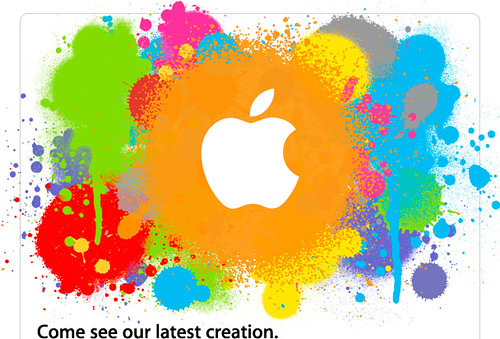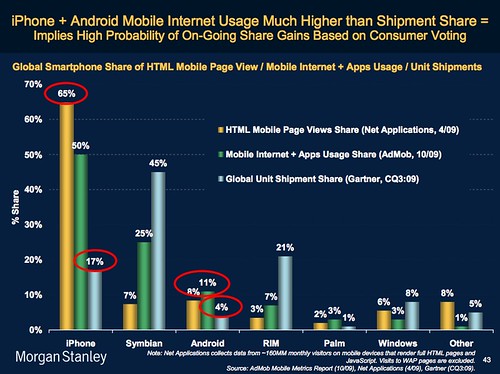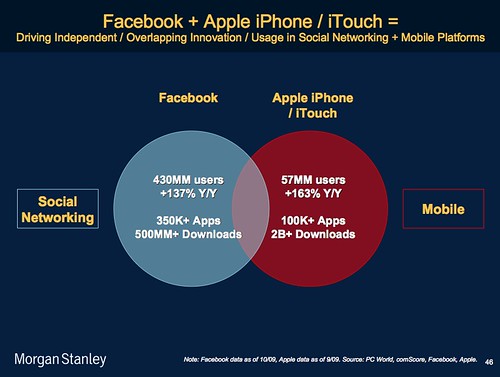Come See Our Latest Creation

For months the Apple rumor mill has been stirring, as usual, whenever there is a build-up to an official Apple event. Each year, there are a half dozen or so Apple events of significance, but two notable events come to mind, WWDC and Macworld. Alas, Apple announced last year that Macworld 2009 would be their last. It surprised very few people, however, when they announced they would do their own event on January 27, 2010.
Notable Apple forecasters and pundits have written several incredibly interesting articles about this upcoming event and just what Apple may release. I've been reading about this speculation for months and several notable posts come to mind. Before reading the rest of my post, I encourage you to read these:
- John Gruber wrote "The Tablet", "Tablet Musings", "The Original Tablet", and "Apple, Adobe, and Flash".
- Andy Ihnatko wrote "Thoughts on what an Apple tablet shout be - or not."
- Marco Arment wrote "'The Tablet' and gadget portability theory", and then this untitled post in response to Jon Siracusa's Tablet post.
- Jon Siracusa wrote "Antacid tablet".
- MG Siegler responded to Joe Wilcox, who is a pro-Microsoft troll writing, "The World Doesn't Need Someone Telling Us What We Don't Need In Tech".
- Neven Mrgan wrote "DIY", "DIY, Pt. II" and "DIY: The Amazon Way".
Tim Van Damme wrote "Dreaming of an Apple Tablet".
- Jim Dalrymple wrote "Prediction: Apple to release two tablets, and other prognostications".
- Aaron Mahnke wrote "Apple's Tablet Device".
- And finally, Leo Laporte, Andy Ihnatko, Alex Lindsay and John Gruber all discussed the tablet for an hour on an episode of MacBreak Weekly.
What Apple Will Announce
Before I get to the topic of the The Tablet, let me first talk about the iPhone.
iPhone on Verizon, T-Mobile and Sprint.
On May 23, 2007, Leslie Cauley of USA Today published a piece quoting that AT&T had signed a 5 year exclusivity contract to sell the iPhone until 2012. Wired's Fred Vogelstein wrote the same thing on January 9, 2008, quoting:
After a year and a half of secret meetings, Jobs had finally negotiated terms with the wireless division of the telecom giant (Cingular at the time) to be the iPhone's carrier. In return for five years of exclusivity, roughly 10 percent of iPhone sales in AT&T stores, and a thin slice of Apple's iTunes revenue, AT&T had granted Jobs unprecedented power. He had cajoled AT&T into spending millions of dollars and thousands of man-hours to create a new feature, so-called visual voicemail, and to reinvent the time-consuming in-store sign-up process. He'd also wrangled a unique revenue-sharing arrangement, garnering roughly $10 a month from every iPhone customer's AT&T bill. On top of all that, Apple retained complete control over the design, manufacturing, and marketing of the iPhone. Jobs had done the unthinkable: squeezed a good deal out of one of the largest players in the entrenched wireless industry.
Steve Jobs gave AT&T just enough to make them happy in exchange for allowing him to make the iPhone the way he wanted it to be made. The iPhone was released and it was an enormous success. Once AT&T saw how much the world loved the iPhone. Apple's iPhone, not AT&T's, they were in a weaker negotiating position. Steve Jobs now had the upper hand over AT&T, which had become dependent on the iPhone as a product due to the enormous rate in which it has been able to sign on new customers for them. Steve Jobs was in a much stronger position. He had something he could take away from AT&T that they desperately wanted to keep and he had something all of the other carriers wanted. He used this new power over the wireless industry. Leslie Cauley of USA Today wrote on on July 31, 2008 that:
Under the original iPhone contract, Apple had the right to offer the device to other carriers beginning in 2009. If Apple exercised that clause, AT&T would have lost one of its biggest points of leverage with customers — exclusive access to the iPhone.
So AT&T caved to Apple's new price structure, which allowed Apple to account for most of the profit for an iPhone up front, rather than spreading it out over the 24 months of a customer's contract. Also...didn't she say a year ago that Apple had a 5 year deal? Didn't Wired report the same details in January of 2008? Something had changed. It appears that, either those two articles were wrong, and that it was a 3 year deal from the beginning, or Jobs managed to rewrite the deal before the iPhone 3GS launch. In either case, the Apple & AT&T marriage is due to expire in 2010. Once again, Leslie Cauley of USA Today backs up this line of thinking saying that:
Verizon (VZ) and Apple (AAPL) are discussing the possible development of an iPhone for Verizon, with the goal of introducing it next year, people familiar with the situation say....
...The New York-based telecom entered into "high-level" discussions with Apple management a few months ago, when CEO Steve Jobs was overseeing day-to-day business, these sources say. They declined to be named because they aren't authorized to speak publicly.
The original iPhone went on sale in June of 2007. It is reasonable to believe that Apple will therefore sell the iPhone on other carriers as early as June 2010, right after WWDC, when the new iPhone hardware is released. The New York Post backs this up, for what it's worth (I don't think very highly of the NY Post).
iPhone 4.0 Software and Hardware
I haven't seen as many leaks about upcoming features to the iPhone OS. The one credible post that I have seen recently was made by Boy Genius Report. In addition to providing a screenshot that looks like a validly leaked developer seed (2B13), they report there will be OS-wide multi-touch gestures. This would make sense if The Tablet is to run the same OS as the iPhone. They also report that Multitasking - running applications in the background - is coming. They hint at an improved home screen and new UI improvements for navigating through the OS. Other features such as new calendar and contact syncing (official Google support, not just using CalDAV?) seem believable as well. I think Steve will preview these new things on stage, releasing the 4.0 SDK to developers soon thereafter so they can get cranking on their apps to be ready to release updates come June/WWDC when the OS & new iPhone hardware is released.
iPhone hardware you say? I have no earthly idea exactly what they could add to this phone hardware-wise to make it better, other than more RAM, more storage, better camera and a faster processor. I'll be happy with just those improvements. I wouldn't put it past Apple to surprise all of us, however, with some new, yet-unthought-of, hardware feature.
The Tablet aka the Canvas
I don't think anyone, at this point, doesn't believe Apple is going to release a touch screen/tablet like device on Wednesday. Earlier today, during their Q4 earning conference call, Steve Jobs was quoted to say, "The new products we are planning to release this year are very strong, starting this week with a major new product that we’re really excited about." Later in the call, Tim Cook says, "I wouldn’t want to take away your joy of surprise on Wednesday when you see our latest creation." Additionally, MacRumors wrote on January 24, 2010 that:
We haven't heard this first hand, but we've heard it multiple times second and third hand from completely independent sources. Senior Apple execs and friends of Jobs are telling people that he's about as excited about the upcoming Apple Tablet as he's ever been.
I think this will be Apple's 4th biggest release within the last 10 years. Release 1 = iPod. Release 2 = Intel-based Macs. Release 3 = iPhone. Release 4 = Canvas. This release has the potential to be just as big, if not bigger, than the previous three.
I think Apple will finally drop the 'i' as a prefix to the name. Apple Canvas, or simply, Canvas. Take your pick. I've seen people throw about iTablet, iPad, iSlate, iCanvas, Apple Tablet, Apple Pad, Apple Slate, Apple Canvas. It could be any of these, or a yet unnamed one. I'm going with Canvas, simply because Apple has hinted at product names in event invitations before. At the event where Apple unveiled the MacBook Air, the invitation tagline was "Something is in the Air." The name was IN the tagline. This invitation? Scroll up and look at it. Doesn't that look like an something an artist might paint on a piece of canvas? Yes, thin reasoning, but I think it fits.
It will be running iPhone/iPod Touch OS 3.2 when he shows it off on stage, set to be running a newer version when it goes on sale in March and eventually 4.0 in June. Some of this is speculation on my part, but at least one mobile app analytics company claims to have seen evidence of this already in their user agent strings within their data.
Will Canvas be Wi-Fi only? Built-in 3G always on internet, sans contract (like the Kindle)? Purchased data-plan from a wireless carrier? Sources have been all over the place on this. Part of me wants to say it will be like the Kindle's Whispernet™, but realistically I think there will be 2 versions, one with Wi-Fi only and the other that you'll able to also purchase a data plan from a wireless carrier.
Will this be a Kindle killer? Well, yes, but not in the way you think. This product isn't aimed at just the Kindle. That's thinking too small. This product is aimed at being a do-everything-you-could-want-device-for-its-size, like the iPhone, that just happens to be able to do everything the Kindle does, but better. Also Apple has been working with book publishers to negotiate content distribution deals within iTunes. Rumors purport that Apple has been talking to publishers such as HarperCollins and McGraw-Hill, and say that Apple may even be working directly with Barnes & Noble. I also think Amazon's Kindle app will still be available to allow Kindle books on the device. Apple wants to kill the competing hardware off, but will allow other company's content to continue to work as well (through their respective apps). Remember Apple is a hardware business. iTunes exists only to support their hardware business. If Kindle and the Nook's books also work on the Canvas, so much the better. Perhaps the owners of those $249 devices will upgrade to a Canvas in 2011 when they tire of their e-ink readers. Having their 20-30 books they purchased through the Kindle or B&N store work on the Canvas go a long way to make the switch easier for them.
And finally, let us all hope Andy Ihnatko makes it to San Francisco before Wednesday.



















